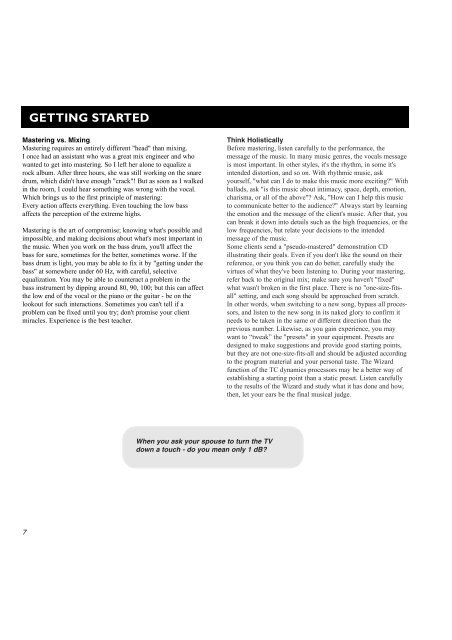2x4cdyD3b
2x4cdyD3b
2x4cdyD3b
You also want an ePaper? Increase the reach of your titles
YUMPU automatically turns print PDFs into web optimized ePapers that Google loves.
GETTING STARTED<br />
Mastering vs. Mixing<br />
Mastering requires an entirely different "head" than mixing.<br />
I once had an assistant who was a great mix engineer and who<br />
wanted to get into mastering. So I left her alone to equalize a<br />
rock album. After three hours, she was still working on the snare<br />
drum, which didn't have enough "crack"! But as soon as I walked<br />
in the room, I could hear something was wrong with the vocal.<br />
Which brings us to the first principle of mastering:<br />
Every action affects everything. Even touching the low bass<br />
affects the perception of the extreme highs.<br />
Mastering is the art of compromise; knowing what's possible and<br />
impossible, and making decisions about what's most important in<br />
the music. When you work on the bass drum, you'll affect the<br />
bass for sure, sometimes for the better, sometimes worse. If the<br />
bass drum is light, you may be able to fix it by "getting under the<br />
bass" at somewhere under 60 Hz, with careful, selective<br />
equalization. You may be able to counteract a problem in the<br />
bass instrument by dipping around 80, 90, 100; but this can affect<br />
the low end of the vocal or the piano or the guitar - be on the<br />
lookout for such interactions. Sometimes you can't tell if a<br />
problem can be fixed until you try; don't promise your client<br />
miracles. Experience is the best teacher.<br />
Think Holistically<br />
Before mastering, listen carefully to the performance, the<br />
message of the music. In many music genres, the vocals message<br />
is most important. In other styles, it's the rhythm, in some it's<br />
intended distortion, and so on. With rhythmic music, ask<br />
yourself, "what can I do to make this music more exciting?" With<br />
ballads, ask "is this music about intimacy, space, depth, emotion,<br />
charisma, or all of the above"? Ask, "How can I help this music<br />
to communicate better to the audience?" Always start by learning<br />
the emotion and the message of the client's music. After that, you<br />
can break it down into details such as the high frequencies, or the<br />
low frequencies, but relate your decisions to the intended<br />
message of the music.<br />
Some clients send a "pseudo-mastered" demonstration CD<br />
illustrating their goals. Even if you don't like the sound on their<br />
reference, or you think you can do better, carefully study the<br />
virtues of what they've been listening to. During your mastering,<br />
refer back to the original mix; make sure you haven't "fixed"<br />
what wasn't broken in the first place. There is no "one-size-fitsall"<br />
setting, and each song should be approached from scratch.<br />
In other words, when switching to a new song, bypass all processors,<br />
and listen to the new song in its naked glory to confirm it<br />
needs to be taken in the same or different direction than the<br />
previous number. Likewise, as you gain experience, you may<br />
want to “tweak” the "presets" in your equipment. Presets are<br />
designed to make suggestions and provide good starting points,<br />
but they are not one-size-fits-all and should be adjusted according<br />
to the program material and your personal taste. The Wizard<br />
function of the TC dynamics processors may be a better way of<br />
establishing a starting point than a static preset. Listen carefully<br />
to the results of the Wizard and study what it has done and how,<br />
then, let your ears be the final musical judge.<br />
When you ask your spouse to turn the TV<br />
down a touch - do you mean only 1 dB?<br />
7


